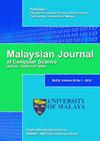FOG ANALYTICS - A SURVEY
IF 1.2
4区 计算机科学
Q4 COMPUTER SCIENCE, ARTIFICIAL INTELLIGENCE
引用次数: 1
Abstract
Fog computing has emerged as an essential alternative to the cloud. Fog computing is the future as it is nearer to the edge where actually the IOT devices and sensors are located. A Fog Server or Fog Node is located near to the IOT devices, connecting directly (wired or wireless) to them. The Fog Server has a functionality of fast accessibility to the data arising out of IOT devices or sensors, as against cloud server which may be located in data centers (near core Network Centers) located far away from the edge resulting in extreme delays in network transmission and latency, especially when the data is large volume as stream (or ‘Big Data’) arising out of IOT devices or sensors including cameras, etc. Real time response after completing the necessary Analytics on the data generated by IOT devices and sensors becomes critically essential for meeting the real time response requirements of critical applications such as in health care and transportation. What are the relevant techniques for Fog Analytics? In this paper we provide a brief survey of Fog Analytics techniques in stream data analytics, machine learning, deep learning techniques and also game theoretical adversarial learning.雾分析——一项调查
雾计算已经成为云的一种重要替代方案。雾计算是未来的趋势,因为它更接近物联网设备和传感器的实际位置。雾服务器或雾节点位于IOT设备附近,直接(有线或无线)连接到这些设备。雾服务器具有快速访问由物联网设备或传感器产生的数据的功能,而云服务器可能位于远离边缘的数据中心(靠近核心网络中心),导致网络传输和延迟的极端延迟,尤其是当物联网设备或传感器(包括摄像头等)产生的大量数据流(或“大数据”)时。在完成对物联网设备和传感器生成的数据的必要分析后,实时响应对于满足医疗保健和交通等关键应用的实时响应要求至关重要。雾分析的相关技术是什么?在本文中,我们简要介绍了流数据分析、机器学习、深度学习技术以及博弈论对抗性学习中的Fog Analytics技术。
本文章由计算机程序翻译,如有差异,请以英文原文为准。
求助全文
约1分钟内获得全文
求助全文
来源期刊

Malaysian Journal of Computer Science
COMPUTER SCIENCE, ARTIFICIAL INTELLIGENCE-COMPUTER SCIENCE, THEORY & METHODS
CiteScore
2.20
自引率
33.30%
发文量
35
审稿时长
7.5 months
期刊介绍:
The Malaysian Journal of Computer Science (ISSN 0127-9084) is published four times a year in January, April, July and October by the Faculty of Computer Science and Information Technology, University of Malaya, since 1985. Over the years, the journal has gained popularity and the number of paper submissions has increased steadily. The rigorous reviews from the referees have helped in ensuring that the high standard of the journal is maintained. The objectives are to promote exchange of information and knowledge in research work, new inventions/developments of Computer Science and on the use of Information Technology towards the structuring of an information-rich society and to assist the academic staff from local and foreign universities, business and industrial sectors, government departments and academic institutions on publishing research results and studies in Computer Science and Information Technology through a scholarly publication. The journal is being indexed and abstracted by Clarivate Analytics'' Web of Science and Elsevier''s Scopus
 求助内容:
求助内容: 应助结果提醒方式:
应助结果提醒方式:


